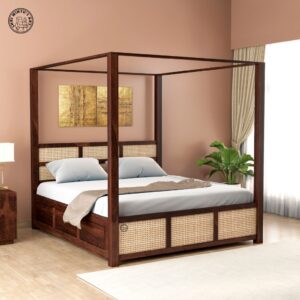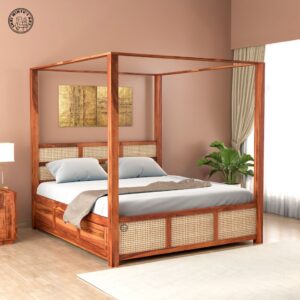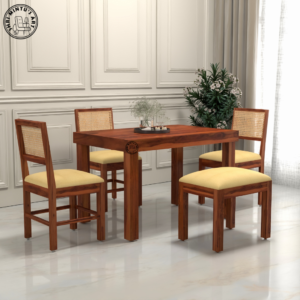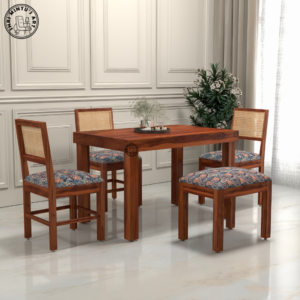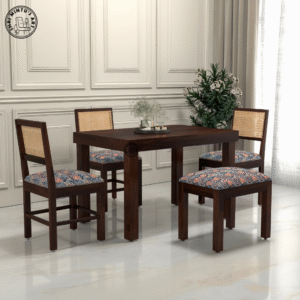The best discounts this week
Every week you can find the best discounts here.
Royale Solid Wood bed
Rivah Solid Wood King Size Bed
Shagun Solid Wood Dining Table
Devika Solid Wood Dining Table Set
Tuna Solid Wood Dining Table set
Vaani Solid Wood Dining Set
Arranging shoes can be quite difficult, particularly if you’re aiming for both practicality and aesthetics in your area. That’s where the discussion of Wooden shoe rack vs Wooden shoe cabinet starts. A shoe rack ensures ease and fast reach, whereas a shoe cabinet delivers sophistication, sturdiness, and hidden storage. Let’s examine them closely so you can determine which one suits your residence, workplace, or store best.
What is a Shoe Rack?
A Wooden shoe rack is a functional and stylish storage solution that keeps shoes organized, protected from dust, and your home clutter-free. Available in open designs for ventilation or Wooden shoe rack Online closed type cabinets for a neat, sophisticated look, they come in various sizes, materials, and styles—from shoes folding rack for small spaces to wall-mounted options for modern, space-saving homes.

Benefits of Shoe Racks
- Affordable – Budget-friendly and accessible in a range of styles, making it fit for all financial plans and aesthetic tastes.
- Compact –Easily fits into tight spaces such as apartments, hostel rooms, or entryways, conserving precious floor space.
- Ventilation – Open shelves enable shoes to air out, avoiding bad smells, moisture accumulation, and bacteria proliferation.
- Portable – Light in weight and convenient to relocate while rearranging furniture, moving residences, or cleaning below.
- Easy Maintenance – Can be swiftly wiped or cleaned with ease, guaranteeing that shoes remain orderly and free of dust at all times.
Types of Shoe Racks
- Closed Shoe Rack –Conceals mess and prevents dust accumulation while providing your foyer with a tidy and stylish appearance.
- Shoes Folding Rack –Collapsible, lightweight, and ideal for compact rented apartments, hostels, or temporary living situations.
- Shoe Rack with Seat and Lock –Functions as a place to sit for ease and offers extra protection for precious shoes.
- Wall-Mounted Rack – An intelligent, space-efficient choice for contemporary residences, allowing the floor to be available for additional necessities.
- Metal or Plastic Shoe Rack –Affordable, robust, and long-lasting, making it a great option for everyday home use.
For commercial places like shops, a slipper stand for shop is also a handy solution to organize daily footwear efficiently.
What is a Shoe Cabinet?
A Wooden shoe cabinet is an enclosed storage solution that keeps shoes hidden, dust-free, and organized, offering a clean, stylish, and clutter-free look to your home. With doors, drawers, or shutters, many designs also include ventilation panels to prevent odors, maintain freshness, and enhance durability—making them perfect for modern, organized living spaces.
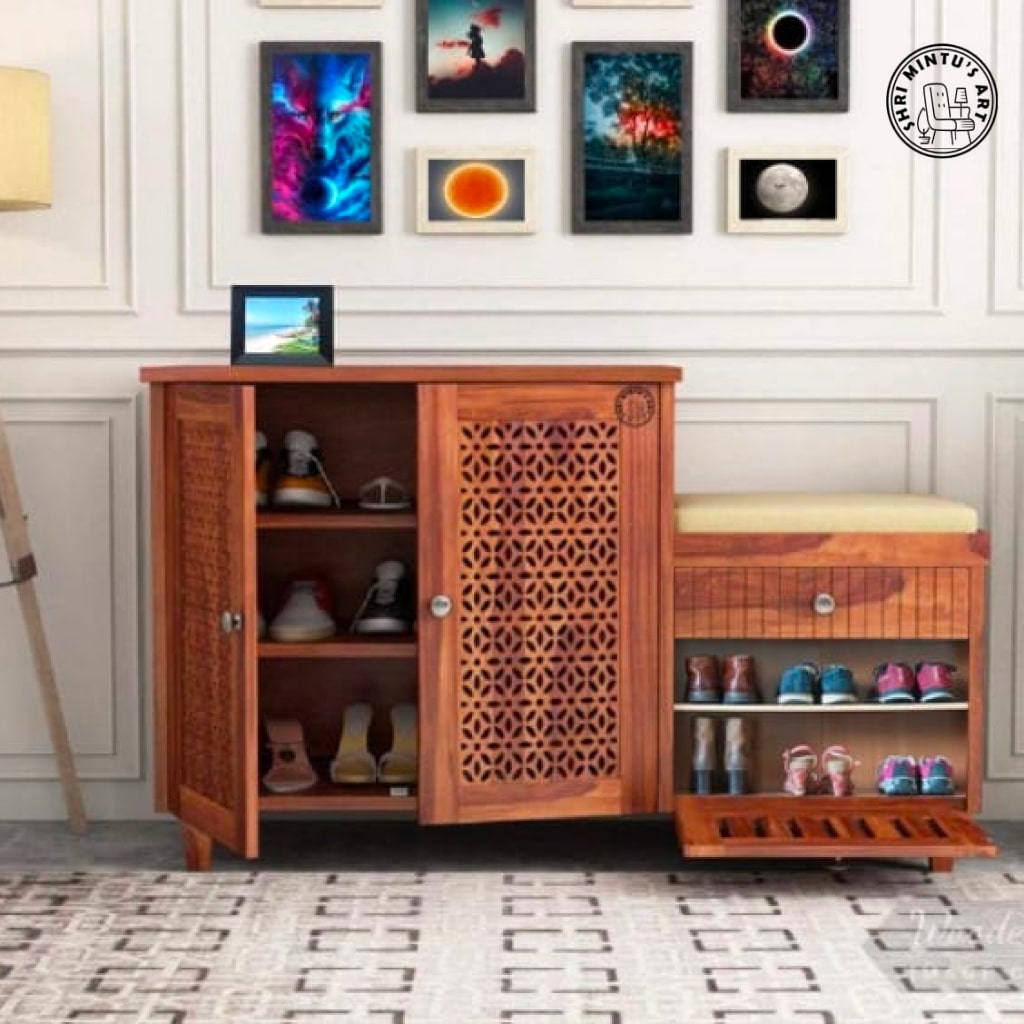
Benefits of Shoe Cabinets
- Stylish Storage – Complements modern interiors like furniture pieces, adding elegance to your entryway.
- Dust-Free – Shoes stay enclosed, clean, and protected from dirt or damage.
- Higher Capacity – Can store 20–50 pairs of shoes neatly, making it ideal for large families.
- Multi-Functional – Some come with drawers, mirrors, or cushioned seating, offering extra utility beyond just storage.
- Durable Materials – Often made from wood, MDF, or engineered panels, ensuring long-lasting performance and a premium look that blends with any décor.
Types of Shoe Cabinets
- Shoe Cabinet with Pull-Out Drawers –Provides convenient access with structured sections, ensuring each pair stays tidy and protected from dust.
- Revolving Shoe Rack Cabinet – A contemporary, space-efficient design that spins for easy access and is suitable for small apartments.
- Wooden Shoe Cabinet Timeless, sturdy, and stylish, bringing enduring charm to spaces while guaranteeing lasting functionality.
- Shoe Rack Cupboard Style –Perfect for big families, offering plenty of storage for several pairs of shoes in one location.
- Entryway Shoe Cabinet –Increases practicality by providing space for shoes and also serves as a chic decorative piece for greeting visitors
Shoe Rack vs Shoe Cabinet: Head-to-Head Comparison
| Feature | Shoe Rack | Shoe Cabinet |
| Design | Open or semi-closed shelves | Fully closed, cupboard-like |
| Appearance | Functional but shoes remain visible | Stylish, elegant, hides clutter |
| Storage Capacity | Small to medium | Large, with multiple compartments |
| Ventilation | Excellent airflow | Enclosed; may trap odor |
| Price | Budget-friendly | Relatively expensive |
| Best Use | Small homes, hostels, shops, quick access | Big families, modern homes, décor-conscious buyers |
| Durability | Lightweight, may wear out | Long-lasting, sturdy design |
How to Choose Between a Shoe Rack and Shoe Cabinet
- If you live in a compact apartment → opt for a shoes folding rack or a wall-mounted one to conserve floor area
- If you want extra features →a Wooden shoe rack with seat and lock provides both multi-use benefits and storage ease.
- For style-conscious homes → go for shoe rack cabinet wooden that matches interiors, blends with furniture, and keeps shoes concealed.
- For modern, space-saving designs →choose a wooden shoe cabinet that complements the decor, harmonizes with furnishings, and keeps footwear out of sight.
- For shops, hostels, or temples → choose a revolving shoe rack or slide-out storage that brings creativity to your foyer.
- If you have a large family → a basic slipper rack is functional, inexpensive, and easy to upkeep for frequent use.
- For dust-free storage →a wooden shoe cabinet with pull-out drawers safeguards shoes from dirt, moisture, and pets.
- For quick access →open shoe racks are ideal, particularly for daily footwear or casual attire

Maintenance & Care Tips
For Shoe Racks
To maintain Wooden shoe racks, dust them weekly with a soft cloth or vacuum to prevent dirt buildup. Avoid placing wet shoes directly on wooden racks; instead, dry them first to prevent damage or fungus. Use deodorizers or baking soda packets to keep shoes fresh and odor-free. Regularly check screws and joints in metal or folding racks to ensure stability. For wooden racks, occasionally apply furniture polish to maintain shine and durability. Additionally, using shoe covers or liners on open shelves helps reduce dust accumulation on shoes.
For Shoe Cabinets
To care for Wooden shoe cabinets, clean surfaces with a damp cloth and dry them immediately to prevent moisture damage. Use air fresheners, camphor balls, or silica gel packs inside to control odor and humidity. Place mats or trays at the entrance to collect dirt and water from footwear. Leave cabinet doors slightly open once a week for airflow and to avoid damp odors. Avoid overloading shelves, as this can damage hinges and reduce the cabinet’s lifespan. Regularly check locks, handles, and sliding doors for smooth operation. For wooden shoe cabinets, apply protective polish to preserve the finish and protect against termites.
Conclusion
The choice between a shoe rack and a shoe cabinet ultimately relies on your budget, available space, and personal lifestyle. A Wooden Shoe Rack is perfect for cost-effectiveness, mobility, airflow, and quick access to daily footwear, while a Wooden Shoe Cabinet offers elegance, hidden storage, higher capacity, and lasting durability for a neat and stylish home. From closed racks to wooden cabinets with pull-out drawers or rotating designs, each option has its own unique benefits.Choose the storage solution that best suits your needs, enhances your décor, and ensures long-lasting organization. By making the right choice, you’ll enjoy clutter-free spaces, better shoe care, and a welcoming entryway.
Discover premium, stylish, and durable Wooden shoe racks and cabinets at Shrimintus, where functionality meets craftsmanship to transform your home.

